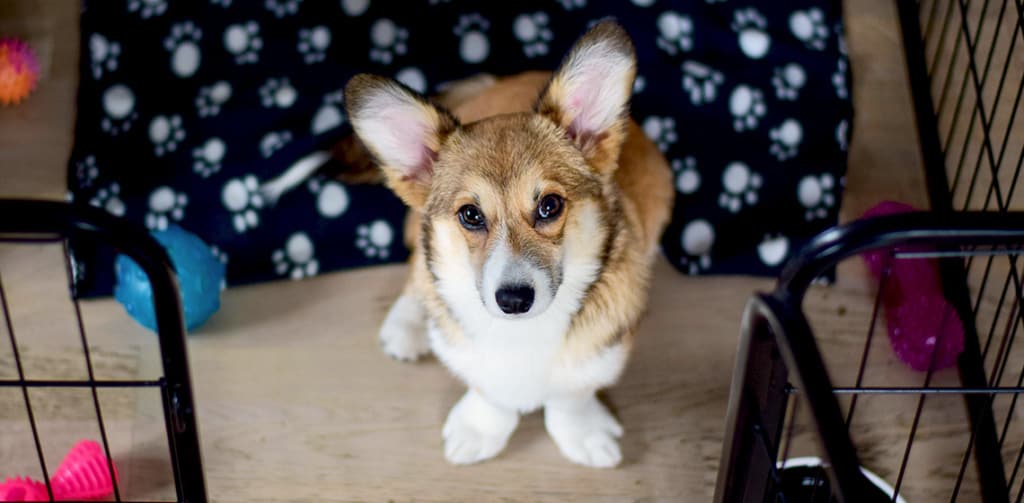It’s such an exciting time when you bring home a new furry family member. You probably can’t wait to get their puppy shots sorted so that you can start your adventure together. You’re probably picturing days filled with walkies and playtime, followed by cozy cuddles with your bundle of joy when you’ve both run out of energy!
But what if things aren’t quite as calm as you imagined when it’s time for bed? If your puppy barks, cries, or whines when they’re in their crate, it can be really frustrating, not to mention disruptive to your own sleep too. But is there really anything you can do about it? Or do some pups just not like being in their crate?
Table of Contents
What are the benefits of crate training your puppy?
If crate training hasn’t been going so well, you might be tempted to throw in the towel. After all, is it absolutely necessary that your pup uses a crate? Well, the truth is it’s definitely worth persevering because getting your puppy used to being in a crate has plenty of benefits. Firstly, if you get your dog used to being in a crate when they are young, it means they’ll be more able to cope if they ever have to travel in one. It’s also perfect practice for being in a kennel at the veterinary clinic, groomer, or boarding kennels.
Providing your dog with a crate can also be beneficial for giving them a safe space away from fireworks, children, or other pets. A crate is also a secure place to keep your dog when you’re not home, preventing destructive behavior and keeping them safe.
If you get your dog used to being in a crate when they are young, it means they’ll be more able to cope if they ever have to travel in one.
Why do puppies cry or whine when left in their crate?
With all the potential benefits, and your efforts to make it nice and pleasant, you might assume that your pup will instantly enjoy spending time in their crate. Or at least, you would expect them to come around to it after a few weeks of gentle persuasion. However, sometimes that’s not the case. Whether they’re bored, lonely, scared, uncomfortable, or wanting attention, there’s usually a reason why your puppy won’t settle in their crate.
What can you do to stop your puppy from crying in their crate?
If your pup keeps whining or crying in their crate, the following tips might help:
Make it cozy, comfortable, and inviting
It might not seem like a big deal, but making sure that your pup’s crate is warm, cozy, and comfortable, is essential. Placing a blanket, cushion, and soft toy in the crate will help, and you could even try adding a piece of clothing that smells of you. Keeping the crate away from drafts and near (but not too near!) a radiator will help to keep your pup feeling toasty. Finally, size does matter! Make sure your puppy’s crate is big enough for them to move around in but not so big that they feel anxious or intimidated.
Try putting them in the crate for a small amount of time, like half an hour, then let them out and give them plenty of attention and stimulation.
Change things gradually
It goes without saying that you shouldn’t put your pup in the crate on day one and abandon them for twelve hours. You might know some people whose puppies have got the hang of using the crate very quickly, but for most, a gradual approach is much better. Try putting them in the crate for a small amount of time, like half an hour, then let them out and give them plenty of attention and stimulation. You can gradually increase the amount of time they are in the crate until they spend the whole night tucked away.
The same gradual approach is important when choosing the location of the crate. It’s best to keep the crate nearby for the first few nights so that you can check on them and they can feel reassured by your presence. As they get more confident in the crate, you can gradually move it further away from you, even downstairs if you wish.
Give regular breaks
Sometimes, if your pup is whining, crying, or barking in their crate, it’s because they need something. Puppies need regular toilet breaks due to their tiny bladders, and their small stomachs mean they tend to eat and drink little and often. The crate you use should be big enough for at least a water bowl, and you’ll need to let your fur baby out every couple of hours to eat or go to the toilet. Over time, their bladder control will improve, and you’ll get to know which cries mean they’re hungry or need to go out and which mean they’re just fidgety.
When you let your pup out of their crate, it’s important to give them plenty of attention and let them work off some energy. This will help them settle when they’re put back in the crate.
If you want your puppy to enjoy chilling out in their crate, you should never use it as a punishment.
Provide activities and distractions
Puzzle feeders, snuffle mats, and puppy-safe chews are all good options for keeping your puppy busy and distracted when they’re in their crate. In fact, if you give them a boredom-busting activity or tasty treat they enjoy at times when they’re in their crate, they’ll begin to associate it with something positive.
Don’t use it for punishment
When it comes to any puppy training, it’s best to use positive reinforcement – rewarding good behavior and ignoring bad behavior. This is especially important when it comes to crate training, though. If you want your puppy to enjoy chilling out in their crate, you should never use it as a punishment.
Stay away!
It’s important to take things slowly with your new pup, and at first, you might find yourself being woken by them more than you’d like. It can be tempting to go to them every time they cry or whine, but by doing this, you may show them that if they make noise, then they will get your attention.
As long as you know that your pup has recently been out to the toilet and has had food and water, you can safely leave them for a small amount of time. Setting a target of leaving them in the crate for half an hour, then an hour, and so on, will help you both to get used to it.
Summary
It can be disheartening when you’ve spent time and money making the perfect setup for your new addition, and they won’t settle in their crate. But if you follow the tips in this article, with patience and perseverance, you and your pup should both get a good night’s sleep soon!
FAQ
If your puppy has been to the toilet recently and has access to food and water, you can let them whine or cry for a small amount of time before going to them. Start by putting them in the crate for half an hour, then gradually build up the time in thirty-minute increments. However, if your puppy barks or cries unusually at any point, you should check on them.
Although it’s important not to rush to your puppy each time they cry in their crate, it’s best to take a gradual approach. Assuming your pup is well, isn’t hungry or thirsty, and doesn’t need to go to the toilet, you can ignore their whines or cries for a small amount of time to see if they settle.

Dr. Hannah Godfrey MRCVS graduated from the Royal Veterinary College in 2011. Although she initially worked in mixed practice treating all species, she found a love for small animal work and has worked exclusively with dogs and cats since 2014. She lives in Wales with her partner, son, and two cats (named Poppy and Ashton Kutcher), and writes comedy fiction in her spare time.








